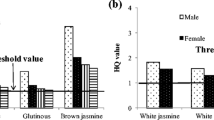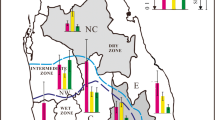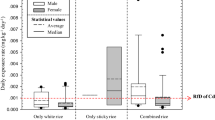Abstract
Consumption of contaminated rice is a toxin exposure route in Asian populations. Since total concentrations generally overestimate health risks, the objectives of this study were to determine the levels of bioaccessible As and Cd in rice cultivated in the Mae Tao, Tak Province and evaluate their potential health impacts in local adults. In total, 59 locally grown rice samples were analyzed for their total and bioaccessible concentrations. Bioaccessible concentrations were obtained from an in vitro digestion process. Inorganic As concentrations were estimated assuming that 63.2–63.5% of the total As is inorganic As. Rice contained inorganic As (45.2% of white rice and 57.1% of sticky rice) and Cd (51.6% of white rice and 32.1% of sticky rice) levels exceeding the Codex standards. The bioaccessibilities of As (16.3–70.0%) and Cd (Null to 83.7%) in rice varied widely. The concentrations of bioaccessible As, which were 1–1.2 times greater than those of bioaccessible Cd, indicate a higher possibility of As absorption into the human body. Positive significant relationships were found between total and bioaccessible As (R2 = 0.568 for white rice and R2 = 0.704 for sticky rice) and Cd (R2 = 0.874 for white rice and R2 = 0.862 for sticky rice). The hazard quotient (HQ) of inorganic As exposure accounted for approximately 93.4% of hazard index (HI). Approximately 2–6 in 10,000 residents over a lifetime of 75 years could suffer from cancer as a result of daily rice consumption. Therefore, the consumption of the home-grown rice in this study should be limited.



Similar content being viewed by others
References
Akkajit, P. (2015). Review of the current situation of Cd contamination in agricultural field in the Mae Sot district, Tak province, northwestern Thailand. Applied Environmental Research, 37(1), 71–82.
Brandon, E., Janssen, P. J. C. M., & Wit-Bos, L. (2014). Arsenic: Bioaccessibility from seaweed and rice, dietary exposure calculations and risk assessment. Food Additives & Contaminants: Part A, 31(12), 1993–2003.
Codex Alimentarius Commission. (2014). Joint FAO/WHO food standards programme (Codex Alimentarius Commission) 37th session Geneva, Switzerland, 14–18 July 2014 and Report of the eighth session of the Codex committee on contaminants in foods, The Hague, The Netherlands, 31 March–4 April 2014. http://www.codexalimentarius.org/download/report/906/REP14_CFe.pdf. Accessed 9 February 2017.
Commonwealth of Australia. (2012). Environmental health risk assessment–guidelines for assessing human health risks from environmental hazards. http://www.eh.org.au/documents/item/916. Accessed 27 March 2017.
Environmental Research Institute, Chulalongkorn University. (2015). Remediation of soil and sediment contamination in Mae Tao watershed, Mae Sot District, Tak Province (in Thai). Bangkok: Thailand.
Gray, P. J., Conklin, S. D., Todorov, T. I., & Kasko, S. M. (2016). Cooking rice in excess water reduces both arsenic and enriched vitamins in the cooked grain. Food Additives & Contaminants: Part A, 33(1), 78–85.
He, Y., Pedigo, C. E., Lam, B., Cheng, Z., & Zheng, Y. (2012). Bioaccessibility of arsenic in various types of rice in an in vitro gastrointestinal fluid system. Journal of Environmental Science and Health, Part B, 47, 74–80.
Hensawang, S., & Chanpiwat, P. (2017). Health impact assessment of arsenic and cadmium intake via rice consumption in Bangkok, Thailand. Environmental Monitoring and Assessment, 189, 599.
Islam, S., Rahman, M. M., Duan, L., Islam, M. R., Kuchel, T., & Naidu, R. (2017). Variation in arsenic bioavailability in rice genotypes using swine model: an animal study. Science of the Total Environment, 599–600, 324–331.
Kim, K. W., Chanpiwat, P., Hanh, H. T., Phan, K., & Sthiannopkao, S. (2011). Arsenic geochemistry of groundwater in Southeast Asia. Frontiers of Medicine, 5(4), 430–433.
Kong, F., & Singh, R. P. (2008). Disintegration of solid foods in human stomach. Journal of Food Science, 73(5), R67–R80.
Land Development Department. (2010). Database on the accumulation of heavy metals and radioactive elements in agricultural soils in Thailand (in Thai). http://osd101.ldd.go.th/HeavyMetal/. Accessed 29 November 2017.
Land Development Department. (2015). State of soil and land resources of Thailand (in Thai). Bangkok: Thailand.
Laparra, J. M., Velez, F., Barbera, R., Farre, R., & Montoro, R. (2005). Bioavailability of inorganic arsenic in cooked rice: Practical aspects for human health risk assessment. Journal of Agricultural and Food Chemistry, 53(22), 8829–8833.
Mandak, E., & NystrÖm, L. (2012). The effects of in vitro digestion on steryl ferulates from rice (Oryza sativa L.) and other grains. Journal of Agricultural and Food Chemistry, 60, 6123–6130.
Ministry of Public Health. (2003). Notification of the Ministry of Public Health (No.273) B.E.2546 (2003): Standard of contaminants in food (in Thai). http://food.fda.moph.go.th/law/data/announ_moph/V.English/No.%20273%20Standard%20of%20contaminants%20in%20food%20(No.%202).pdf. Accessed 6 June 2016.
National Bureau of Agricultural Commodity and Food Standards, Ministry of Agriculture and Cooperatives. (2016). Food consumption data of Thailand (in Thai). http://www.acfs.go.th/document/download_document/FCDT.pdf. Accessed 1 March 2017.
National Electronics and Computer Technology Center. (2011). SizeThailand (in Thai). http://sizethailand.org/region_all.html. Accessed 1 August 2017.
National Statistical Office. (2016). Tak Provincial Statistic Report (in Thai). http://tak.old.nso.go.th/nso/project/search/index.jsp?province_id=49&fid=3&pro_code=O-src-10&pro_year=2559&data_type=3. Accessed 15 December 2017.
Nookabkaew, S., Rangkadilok, N., Akib, C. A., Tuntiwigit, N., Saehun, J., & Satayavivar, J. (2013a). Evaluation of trace elements in selected foods and dietary intake by young children in Thailand. Food Additives & Contaminants: Part B, 6(1), 55–67.
Nookabkaew, S., Rangkadilok, N., Mahidol, C., Promsuk, G., & Satayavivar, J. (2013b). Determination of arsenic species in rice from Thailand and other Asian countries using simple extraction and HPLC-ICP-MS analysis. Journal of Agricultural and Food Chemistry, 61, 6991–6998.
Official Statistics Registration Systems. (2016). Number of population in the different age groups for the sub-district level (in Thai). http://stat.dopa.go.th/stat/statnew/upstat_age.php. Accessed 15 December 2017.
Phan, K., Sthiannopkao, S., Heng, S., Phan, S., Huoy, L., Wong, M. H., et al. (2013). Arsenic contamination in the food chain and its risk assessment of populations residing in the Mekong River basin of Cambodia. Journal of Hazardous Materials, 262, 1064–1071.
Simmons, R. W., Pongsakul, P., Saiyasitpanich, D., & Klinphoklap, S. (2005). Elevated levels of cadmium and zinc in paddy soils and elevated levels of cadmium in rice grain downstream of a zinc mineralized area in Thailand: Implications for public health. Environmental Geochemistry and Health, 27, 501–511.
Songprasert, N., Sukaew, T., Kusreesakul, K., Swaddiwudhipong, W., Padungtod, C., & Bundhamcharoen, K. (2015). Additional burden of diseases associated with cadmium exposure: A case study of cadmium contaminated rice fields in Mae Sot District, Tak Province, Thailand. International Journal of Environmental Research and Public Health, 12, 9199–9217.
Sriprachote, A., Kanyawongha, P., Ochiai, K., & Matoh, T. (2012). Current situation of cadmium-polluted paddy soil, rice, and soybean in the Mae Sot District, Tak Province, Thailand. Soil Science and Plant Nutrition, 58, 349–359.
Storck, C., da Silva, L. P., & Fagundes, C. A. A. (2005). Categorizing rice cultivars based on differences in chemical composition. Journal of Food Composition and Analysis, 18(4), 333–341.
Sun, G. X., de Wiele, T. V., Alava, P., Tack, F., & Laing, G. D. (2012). Arsenic in cooked rice: Effect of chemical, enzymatic and microbial processes on bioaccessibility and speciation in the human gastrointestinal tract. Environmental Pollution, 162, 241–246.
Taylor, R. (1990). Interpretation of the correlation coefficient: A basic review. https://studysites.sagepub.com/salkind2study/articles/05Article01.pdf. Accessed 9 September 2017.
Tóth, G., Hermann, T., da Silva, M. R., & Montanarella, L. (2016). Heavy metals in agricultural soils of the European Union with implications for food safety. Environment International, 88, 299–309.
U.S. Environmental Protection Agency (U.S. EPA). (1989). Risk assessment guidance for superfund volume I human health evaluation manual (Part A) Interim Final. (EPA/540/1-89/002 December 1989) https://www.epa.gov/sites/production/files/2015-09/documents/rags_a.pdf. Accessed 2 March 2017.
U.S. Environmental Protection Agency (U.S. EPA). (2016a). Arsenic, inorganic (CASRN 7440-38-2). https://cfpub.epa.gov/ncea/iris2/chemicalLanding.cfm?substance_nmbr=278. Accessed 18 May 2016.
U.S. Environmental Protection Agency (U.S. EPA). (2016b). Cadmium (CASRN 7440-43-9). https://cfpub.epa.gov/ncea/iris2/chemicalLanding.cfm?substance_nmbr=141. Accessed 18 May 2016.
Versantvoort, C. H. M., van de Camp, E., & Rompelberg, C. J. M. (2004). RIVM report 320102002/2004: development and applicability of an in vitro digestion model in assessing the bioaccessibility of contaminants from food. National Institute for Public Health and the Environment, Ministry of Health, Welfare and Sport. Netherlands. http://www.rivm.nl/en/Documents_and_publications/Scientific/Reports/2004/april/Development_and_applicability_of_an_in_vitro_digestion_model_in_assessing_the_bioaccessibility_of_contaminants_from_food. Accessed 4 September 2017.
Wang, C., Duan, H. Y., & Teng, J. W. (2014). Assessment of microwave cooking on the bioaccessibility of cadmium from various food matrices using an in vitro digestion model. Biological Trace Element Research, 160(2), 276–284.
Wei, Y., Zheng, X., Shohag, Md J I, & Gu, M. (2017). Bioaccessibility and human exposure assessment of cadmium and arsenic in Pakchoi genotypes grown in co-contaminated soils. International Journal of Environmental Research and Public Health, 14, 977.
World Health Organization. (2012). Life expectancy. http://www.who.int/gho/countries/tha/country_profiles/en/. Accessed 15 June 2016.
Yang, L. S., Zhang, X. W., Li, Y. H., Li, H. R., Wang, Y., & Wang, W. Y. (2012). Bioaccessibility and risk assessment of cadmium from uncooked rice using an in vitro digestion model. Biological Trace Element Research, 145, 81–86.
Zhao, D., Liu, R. Y., Xiang, P., Juhasz, A. L., Huang, L., Luo, J., et al. (2017). Applying cadmium relative bioavailability to assess dietary intake from rice to predict cadmium urinary excretion in nonsmokers. Environmental Science and Technology, 51, 6756–6764.
Zhuang, P., Zhang, C., Li, Y., Zou, B., Mo, H., Wu, K., et al. (2016). Assessment of influences of cooking on cadmium and arsenic bioaccessibility in rice, using an in vitro physiologically-based extraction test. Food Chemistry, 213, 206–214.
Acknowledgements
This research was financially supported by the International Environmental Research Institute (IERI) of Gwangju Institute of Science and Technology (GIST), Republic of Korea. The authors would like to thank the Office of Higher Education Commission (OHEC) and the S&T Postgraduate Education and Research Development Office (PERDO) for the financial support of the Research Program. The authors would like to also express sincere thanks to the Environmental Research Institute (ERIC), Chulalongkorn University and the Center of Excellence on Hazardous Substance Management (HSM), for their invaluable support in terms of facilities and scientific equipments.
Author information
Authors and Affiliations
Corresponding author
Electronic supplementary material
Below is the link to the electronic supplementary material.
Rights and permissions
About this article
Cite this article
Chanpiwat, P., Hensawang, S., Suwatvitayakorn, P. et al. Risk assessment of bioaccessible arsenic and cadmium exposure through rice consumption in local residents of the Mae Tao Sub-district, Northwestern Thailand. Environ Geochem Health 41, 343–356 (2019). https://doi.org/10.1007/s10653-018-0098-8
Received:
Accepted:
Published:
Issue Date:
DOI: https://doi.org/10.1007/s10653-018-0098-8




